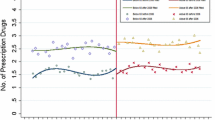Abstract
Objective: To explore the relevance of prescription changes and related drug costs when patients are referred from primary to secondary care.
Patients and methods: Secondary analysis of data derived from a study on the quality of referrals, which was performed in 1989–1990. New and non-acute referrals of ambulatory patients were studied for internal medicine, neurology, and dermatology. Diagnoses were coded according to the ICPC, and drug names were coded according to the ATC. Prescription data were collected from referral letters and questionnaires. Drugs were also coded as generic or brand name products. Cost of treatment was calculated on the basis of information in the 1989 edition of the Dutch Public Health Care Drug Compendium taking into account the price of the drug and the duration of the prescription. Potential savings were calculated for those brand name products for which substitution by a similar drug was possible.
Results: Data on 289 referrals, representing 289 patients, were available for analysis. In 126 out of the 289 patients (43.6%), specialists added to or changed prescriptions initiated by the general practitioner (GP). Specialist prescribing tended to shift to more chronic use. The costs of specialist prescribing are on average 23% higher than for GP prescriptions. Although specialists had fewer opportunities for generic substitution, the potential for savings was greater than for GPs. In many cases, the specialists changed the diagnosis. Only in neurology was the relative risk of receiving a prescription increased when the diagnosis changed.
Conclusion: Specialists have considerable influence on prescribing to outpatients. The number of prescriptions and the related costs increased greatly when patients were referred from primary to secondary care. The opportunities for generic substitution, and therefore for possible savings, are not fully exploited by GPs or specialists.
Similar content being viewed by others
Author information
Authors and Affiliations
Additional information
Received: 23 September 1997 / Accepted in revised form: 7 March 1998
Rights and permissions
About this article
Cite this article
Bijl, D., Van Sonderen, E. & Haaijer-Ruskamp, F. Prescription changes and drug costs at the Interface between primary and specialist care. E J Clin Pharmacol 54, 333–336 (1998). https://doi.org/10.1007/s002280050469
Issue Date:
DOI: https://doi.org/10.1007/s002280050469




